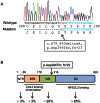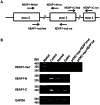Identification of a KEAP1 germline mutation in a family with multinodular goitre
- PMID: 23724128
- PMCID: PMC3665763
- DOI: 10.1371/journal.pone.0065141
Identification of a KEAP1 germline mutation in a family with multinodular goitre
Abstract
Background: The familial clustering of multinodular goitres (MNGs) with a dominant mode of inheritance has been repeatedly reported. Linkage studies have revealed several genetic loci responsible for familial MNG; however, most of the causative variants remain unknown.
Methods and results: Through linkage analysis using single-nucleotide polymorphism markers, we identified a new MNG locus on 19p13.2-q12 in a five-generation Japanese MNG family. Subsequent mutation searches focusing on the candidate 25-Mb region of chromosome 19 identified a heterozygous mutation, c.879_880delinsA, p.Asp294Thr, fs*23, in exon 3 of the KEAP1, which plays a central role in the cytoprotection pathway against oxidative stress. Reverse transcriptase-PCR analysis showed low expression of wild type KEAP1 accompanied by no transcription product of mutant allele in the normal and goitre region of thyroid tissues obtained from the proband. In agreement with previous studies showing that KEAP1 negatively regulates NFE2L2, the NFE2L2 target genes GSTA4 and GCLC were up-regulated in the thyroid tissues of the patient.
Conclusions: This study identified the first KEAP1 mutation in MNG. The results provide insights into the pathogenesis of goitre which develops in the organ continuously exposed to oxidative stress during hormone synthesis.
Conflict of interest statement
Figures





References
-
- Knudsen N, Perrild H, Christiansen E, Rasmussen S, Dige-Petersen H, et al. (2000) Thyroid structure and size and twoyear follow-up of solitary cold thyroid nodules in an unselected population with borderline iodine deficiency. Eur J Endocrinol 142: 224–230. - PubMed
-
- Krohn K, Führer D, Bayer Y, Eszlinger M, Brauer V, et al. (2005) Molecular pathogenesis of euthyroid and toxic multinodular goiter. Endocr Rev 26: 504–524. - PubMed
-
- Hegedüs L, Bonnema SJ, Bennedbaek FN (2003) Management of simple nodular goiter: Current status and future perspectives. Endocr Rev 24: 102–132. - PubMed
-
- Laurberg P, Jørgensen T, Perrild H, Ovesen L, Knudsen N, et al. (2006) The Danish investigation on iodine intake and thyroid disease. Eur J Endocrinol 155: 219–228. - PubMed
-
- Brix TH, Hegedüs L (2000) Genetic and environmental factors in the aetiology of simple goiter. Ann Med 32: 153–156. - PubMed
Publication types
MeSH terms
Substances
LinkOut - more resources
Full Text Sources
Other Literature Sources
Miscellaneous

